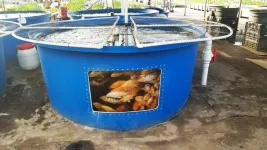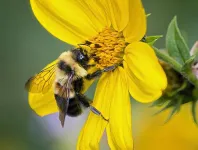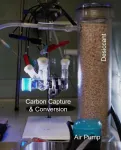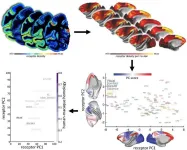(Press-News.org) The analysis, which appears in the journal Nature Reviews Earth and Environment, also points to ways to improve assessments in order to achieve sustainable water use and food production in the future.
“Even though irrigation covers a small fraction of the earth, it has a significant impact on regional climate and environments—and is either already unsustainable, or verging on towards scarcity, in some parts of the world,” explains Sonali Shukla McDermid, an associate professor in NYU’s Department of Environmental Studies and the paper’s lead author. “But because irrigation supplies 40% of the world’s food, we need to understand the complexities of its effects so we can reap its benefits while reducing negative consequences.”
Irrigation, which is primarily used for agricultural purposes, accounts for roughly 70% of global freshwater extractions from lakes, rivers, and other sources, amounting to 90% of the world’s water usage. Previous estimates suggest that more than 3.6 million square kilometers —or just under 1.4 million square miles—of the earth’s land are currently irrigated. Several regions, including the US high plains states, such as Kansas and Nebraska, California’s Central Valley, the Indo-Gangetic Basin spanning several South Asian countries, and northeastern China, are the world’s most extensively irrigated and also display among the strongest irrigation impacts on the climate and environment.
While work exists to document some impacts of irrigation on specific localities or regions, it’s been less clear if there are consistent and strong climate and environmental impacts across global irrigated areas—both now and in the future.
To address this, a total of 38 researchers from the US, Australia, Austria, Belgium, France, India, Italy, Japan, South Korea, and Taiwan analyzed more than 200 previous studies—an examination that captured both present-day effects and projected future impacts.
Their review pointed to both positive and negative effects of irrigation, including the following:
Irrigation can cool daytime temperatures substantially and can also change how agroecosystems store and cycle carbon and nitrogen. While this cooling can help combat heat extremes, irrigation water can also humidify the atmosphere and can result in the release of greenhouse gasses, such as powerful methane from rice.
The practice annually withdraws an estimated 2,700 cubic kilometers from freshwater sources, or nearly 648 cubic miles, which is more water than is held by Lake Erie and Lake Ontario combined. In many areas, this usage has reduced water supplies, particularly groundwater, and has also contributed to the runoff of agricultural inputs, such as fertilizers, into water supplies.
Irrigation can also impact precipitation in some areas, depending on the locale, season, and prevailing winds.
The researchers also propose ways to improve irrigation modeling—changes that would result in methods to better assess ways to achieve sustainable water and food production into the future.
These largely center on adopting more rigorous testing of models as well as more and better ways of identifying and reducing uncertainties associated with both the physical and chemical climate processes and—importantly—human decision-making. The latter could be done with more coordination and communication between scientists and water stakeholders and decision-makers when developing irrigation models.
“Such assessments would allow scientists to more comprehensively investigate interactions between several, simultaneously changing conditions, such as regional climate change, biogeochemical cycling, water resource demand, food production, and farmer household livelihoods—both now and in the future,” observes McDermid.
An image depicting different agricultural land-use practices may be downloaded here (Image courtesy of NASA/METI/AIST/Japan Space Systems and U.S./Japan ASTER Science Team).
This research was supported by the National Science Foundation (1752729, 2127643), the National Research Foundation of Korea, and the Japan Science and Technology Agency.
# # #
END
New study reveals irrigation’s mixed effects around the world
Trajectory of irrigation water use in many regions is unsustainable, but practice is vital in managing climate change and future agricultural development, researchers conclude
2023-06-20
ELSE PRESS RELEASES FROM THIS DATE:
Open-source software to speed up quantum research
2023-06-20
Quantum technology is expected to fundamentally change many key areas of society. Researchers are convinced that there are many more useful quantum properties and applications to explore than those we know today. A team of researchers at Chalmers University of Technology in Sweden have now developed open-source, freely available software that will pave the way for new discoveries in the field and accelerate quantum research significantly.
Within a few decades, quantum technology is expected to become a key technology in areas such as health, communication, defence and energy. The ...
Fish farms can become biogas producers
2023-06-20
Digesting fish waste can allow circular fish and vegetable farms (aquaponics) to produce biogas that can be fed back into the energy system of these farms. This also generates excellent nutrition for plants, according to new research from the University of Gothenburg.
There is increasing growth in circular, land-based, combined fish and vegetable farms- often referred to as aquaponics. Aquaponics makes use of nutrient-rich water produced by fish (aquaculture) which can be used to fertilise plants (hydroponics) ...
Machine learning helps researchers identify hit songs with 97% accuracy
2023-06-20
Every day, tens of thousands of songs are released. This constant stream of options makes it difficult for streaming services and radio stations to choose which songs to add to playlists. To find the ones that will resonate with a large audience, these services have used human listeners and artificial intelligence. This approach, however, lingering at a 50% accuracy rate, does not reliably predict if songs will become hits.
Now, researchers in the US have used a comprehensive machine learning technique applied to brain responses and were able to predict ...
Completing genome of rusty patched bumble bee may offer new approach to saving endangered bee
2023-06-20
LOGAN, Utah, June 20, 2023 — A detailed, high-resolution map of the rusty patched bumble bee’s genome has been released by U.S. Department of Agriculture (USDA) Agricultural Research Service (ARS) and U.S. Fish and Wildlife Service (USFWS) scientists, offering new possible approaches for bringing the native pollinator back from the danger of extinction.
Putting together the rusty patched bumble bee genome is part of the Beenome 100 project, a first-of-its-kind effort to create a library of high-quality, ...
Face of Anglo-Saxon teen VIP revealed with new evidence about her life
2023-06-20
The face of a 16-year-old woman buried near Cambridge (UK) in the 7th century with an incredibly rare gold and garnet cross (the ‘Trumpington Cross’) has been reconstructed following analysis of her skull. The striking image is going on public display for the first time on 21st June, with new scientific evidence showing that she moved to England from Central Europe as a young girl, leading to an intriguing change in her diet.
The image and artefacts from the mysterious woman’s ...
Weak policies and political ideologies risk jeopardizing plans to tackle health and climate change, says Cambridge expert
2023-06-20
Weak policies and political ideologies risk jeopardising plans to tackle health and climate change, says Cambridge expert
Efforts to tackle major issues facing the UK, including the nation’s health and climate change, are being hampered because politicians often ignore the existing evidence when setting policies, according to Dame Theresa Marteau, a public health expert at the University of Cambridge.
Writing in the journal Science and Public Policy, Professor Marteau argues that this ‘evidence-neglect’ is a result of incentive structures that encourage politicians to set ambitious policy goals while simultaneously disincentivising ...
Low-dose aspirin use associated with 20% increased anemia risk in older adults
2023-06-19
1. Low-dose aspirin use associated with 20% increased anemia risk in older adults
Abstract: https://www.acpjournals.org/doi/10.7326/M23-0675
URL goes live when the embargo lifts
An analysis of the ASPREE (ASPirin in Reducing Events in the Elderly) trial found that the use of low-dose aspirin was associated with a 20 percent increased incidence of anemia and decline in ferritin, or blood iron levels, in otherwise healthy older adults. These findings suggest that periodic monitoring of hemoglobin should be considered in older patients taking aspirin. The analysis is published in Annals ...
Chinese paleogeneticist FU Qiaomei awarded UNESCO–AI Fozan International Prize for the Promotion of Young Scientists
2023-06-19
FU Qiaomei, a paleogeneticist at the Chinese Academy of Sciences (CAS), received the UNESCO–AI Fozan International Prize for the Promotion of Young Scientists in Science, Technology, Engineering and Mathematics (STEM) on June 19 in Paris, France, for her “seminal work on the history of early humans in Eurasia, based on genetic lineage studies, which provides new insights on the early human history of Eurasia and perspectives on the evolution of human health.”
She was one of five young scientists from around the world to receive the prize, alongside researchers from Argentina, Cameroon, Egypt, and Serbia. The laureates were ...
Clean, sustainable fuels made ‘from thin air’ and plastic waste
2023-06-19
Researchers have demonstrated how carbon dioxide can be captured from industrial processes – or even directly from the air – and transformed into clean, sustainable fuels using just the energy from the Sun.
The researchers, from the University of Cambridge, developed a solar-powered reactor that converts captured CO2 and plastic waste into sustainable fuels and other valuable chemical products. In tests, CO2 was converted into syngas, a key building block for sustainable liquid fuels, and plastic bottles were converted into glycolic acid, which is widely used in the cosmetics industry.
Unlike earlier tests ...
Human Brain Project study offers insights into neuroreceptor organization
2023-06-19
A key challenge in neuroscience is to understand how the brain can adapt to a changing world, even with a relatively static anatomy. The way the brain’s areas are structurally and functionally related to each other – its connectivity – is a key component. In order to explain its dynamics and functions, we also need to add another piece to the puzzle: receptors. Now, a new mapping by Human Brain Project (HBP) researchers from the Forschungszentrum Jülich (Germany) and Heinrich-Heine-University Düsseldorf (Germany), in collaboration with scientists from the University of Bristol (UK), ...
LAST 30 PRESS RELEASES:
Norbert Holtkamp appointed director of Fermi National Accelerator Laboratory
New agentic AI platform accelerates advanced optics design
Biologists discover neurons use physical signals — not electricity — to stabilize communication
Researchers discover that a hormone can access the brain by hitchhiking
University of Oklahoma researcher awarded funding to pursue AI-powered material design
Exploring how the visual system recovers following injury
Support for parents with infants at pediatric check-ups leads to better reading and math skills in elementary school
Kids’ behavioral health is a growing share of family health costs
Day & night: Cancer disrupts the brain’s natural rhythm
COVID-19 vaccination significantly reduces risk to pregnant women and baby
The role of vaccination in maternal and perinatal outcomes associated with COVID-19 in pregnancy
Mayo Clinic smartwatch system helps parents shorten and defuse children's severe tantrums early
Behavioral health spending spikes to 40% of all children’s health expenditures, nearly doubling in a decade
Digital cognitive behavioral treatment for generalized anxiety disorder
Expenditures for pediatric behavioral health care over time and estimated family financial burden
Air conditioning in nursing homes and mortality during extreme heat
The Alps to lose a record number of glaciers in the next decade
What makes a good proton conductor?
New science reporting guide published for journalists in Bulgaria
New international study reveals major survival gaps among children with cancer
New science reporting guide published for journalists in Turkey
Scientists develop a smarter mRNA therapy that knows which cells to target
Neuroanatomy-informed brain–machine hybrid intelligence for robust acoustic target detection
Eight SwRI hydrogen projects funded by ENERGYWERX
The Lundquist Institute and its start-up company Vitalex Biosciences Announces Strategic Advancement of Second-Generation fungal Vaccine VXV-01 through Phase 1 Trials under $40 Million Competitive Con
Fine particles in pollution are associated with early signs of autoimmune disease
Review article | Towards a Global Ground-Based Earth Observatory (GGBEO): Leveraging existing systems and networks
Penn and UMich create world’s smallest programmable, autonomous robots
Cleveland researchers launch first major study to address ‘hidden performance killer’ in athletes
To connect across politics, try saying what you oppose
[Press-News.org] New study reveals irrigation’s mixed effects around the worldTrajectory of irrigation water use in many regions is unsustainable, but practice is vital in managing climate change and future agricultural development, researchers conclude






